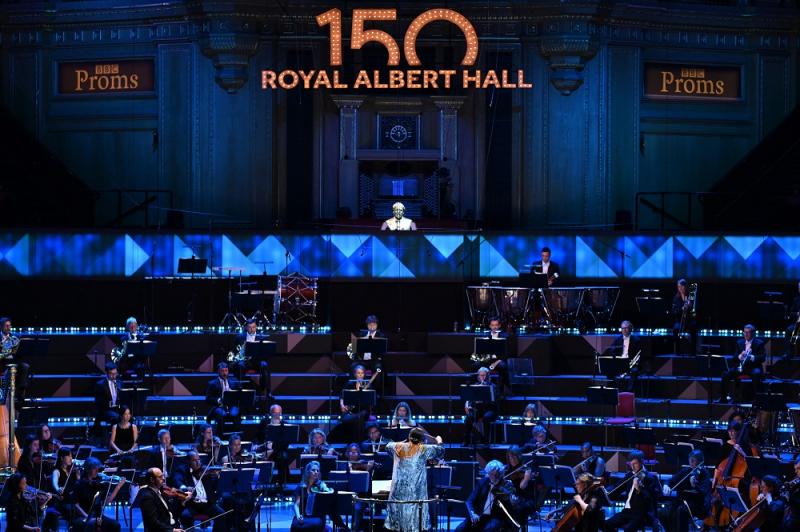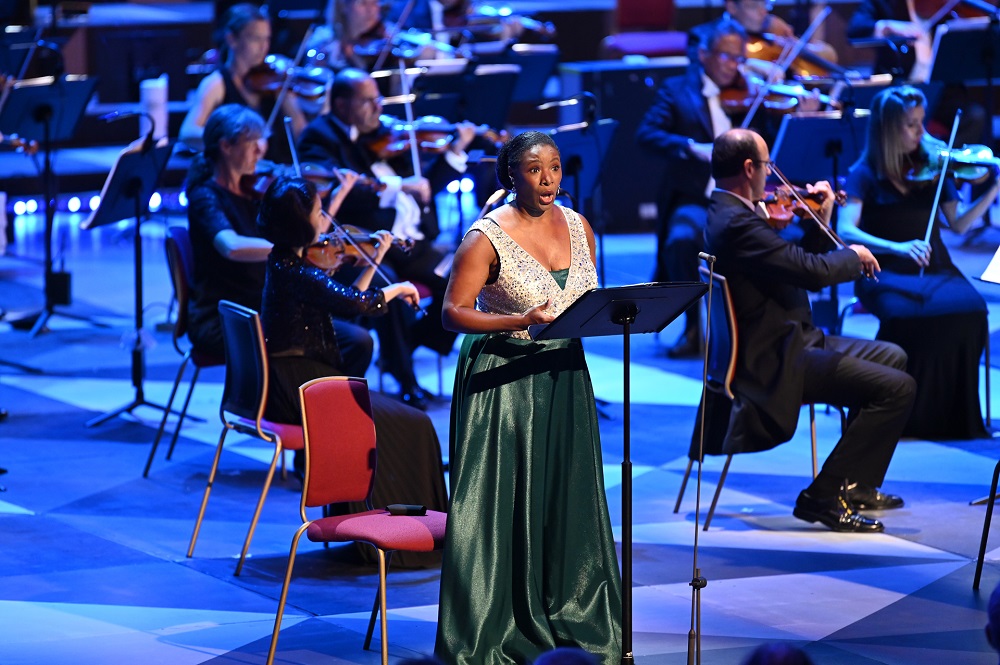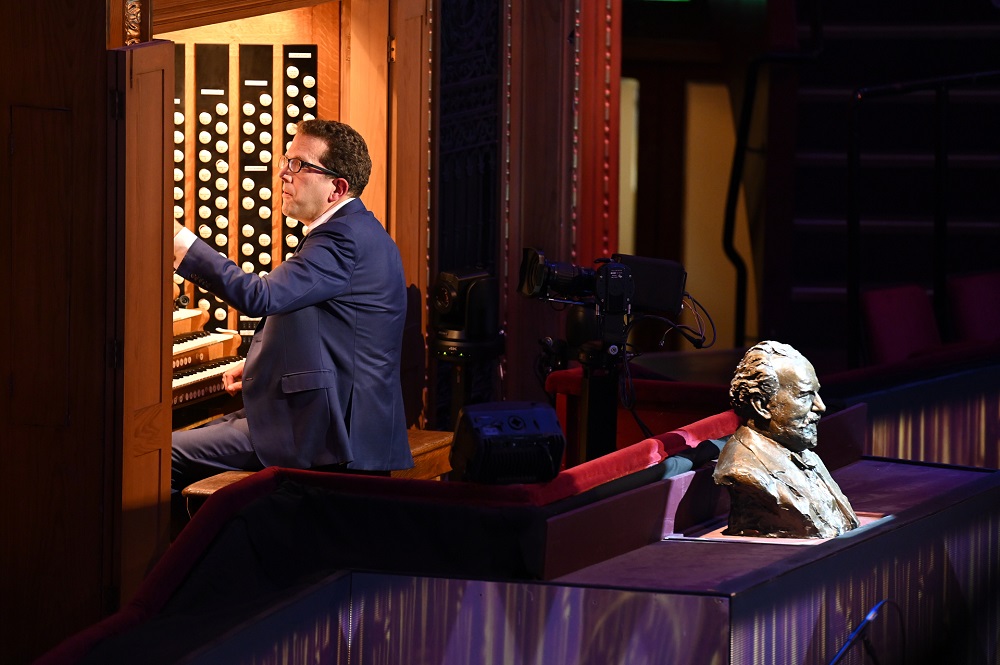First Night of the Proms, Hyde, BBCSO, Stasevska review - levitational ecstasies | reviews, news & interviews
First Night of the Proms, Hyde, BBCSO, Stasevska review - levitational ecstasies
First Night of the Proms, Hyde, BBCSO, Stasevska review - levitational ecstasies
Finn floats and ignites a well conceived programme back in the Royal Albert Hall

Did absence from Albert’s colosseum from early September 2019 until now and a roof-raising finale hoodwink many of us into thinking Dalia Stasevska’s interpretation of Sibelius’s Second Symphony among the greats? Having listened to it again on the BBC Radio 3 iPlayer this morning, I'm convinced not; this was the real deal.
You almost felt the Albert Hall should have been greeting us back in black and white for this year's Proms, like an audience returning after the Second World War. Many things were not quite the same: you ran the gamut of the exceedingly polite and welcoming folk at the doors asking to see your Covid vaccination certificate, masks were worn in seats, apparently optional – not the best of decisions when you’re located in batches all together – and while the platform was bigger, the Arena was much smaller, with what seemed like a smattering of Prommers around the big camera cordon. But the spirit was there at the start and so overwhelmingly at the final ovation.  It was inspired to begin with soft levitational ecstasy rather than a fanfaring bang. Vaughan Williams’ Serenade to Music is one of those spiritual works which needs the Albert Hall halo around it; Stasevska made the BBCSO strings, on top form these days, glow and levitate supernaturally, capped by the beauty of leader Igor Yuzefovich’s secret raptures. Inevitably not that many of Shakespeare’s words from Act Five of The Merchant of Venice could be made out in the hall, but what impact from the 17 voices of the BBC Singers placed high behind the orchestra to the right, and what sounds from a quartet of soloists. Yes, it’s always impressive to hear the 16 singers Vaughan Williams requested, but nothing else was missed from this quartet of two established national treasures – soprano Elizabeth Llewellyn (pictured above) and tenor Allan Clayton, ringing out as ever in this space – and two younger artists, contralto Jess Dandy and bass-baritone Michael Mofidian.
It was inspired to begin with soft levitational ecstasy rather than a fanfaring bang. Vaughan Williams’ Serenade to Music is one of those spiritual works which needs the Albert Hall halo around it; Stasevska made the BBCSO strings, on top form these days, glow and levitate supernaturally, capped by the beauty of leader Igor Yuzefovich’s secret raptures. Inevitably not that many of Shakespeare’s words from Act Five of The Merchant of Venice could be made out in the hall, but what impact from the 17 voices of the BBC Singers placed high behind the orchestra to the right, and what sounds from a quartet of soloists. Yes, it’s always impressive to hear the 16 singers Vaughan Williams requested, but nothing else was missed from this quartet of two established national treasures – soprano Elizabeth Llewellyn (pictured above) and tenor Allan Clayton, ringing out as ever in this space – and two younger artists, contralto Jess Dandy and bass-baritone Michael Mofidian.
They returned for the counterweight at the beginning of the second half (yes, we’re back to full programmes at the Proms). In When Soft Voices Die, a BBC co-commission shared with Help Musicians, the organisation which has done so much to help artists stay afloat in the last 16 months (keep on giving, please), James MacMillan reflects Vaughan Williams’ Shakespeare with settings of two poems by Shelley, moving upwards through the lower three voices in the evanescence of “The flower that smiles today” and moving on to the second poem, “Music, when soft voices die”, for affirmative ecstasy from the soprano, the quartet joining in the last quatrain. The shape is clear and well contrasted, with some anguish from the tenor, scalic calm from the contralto, but after the arresting opening murmurs of lower instruments, the work is pleasing but doesn’t seem to come from any deep place. Oddly, it was the most conventional piece of the evening’s four.  There’s no sense of placid familiarity with the mostly solemn strangeness of Poulenc’s Concerto for Organ, Strings and Timpani, offering its own form of neo-Baroque without ever sounding like pastiche. What better than the Albert Hall King of Instruments for the apocalyptic summons, boldly mastered by Daniel Hyde (pictured above)? Stasevska managed to maintain string profile even in the most ethereal moments, and the challenge of togetherness with the soloist when the combined forces briefly romp was bracingly met.
There’s no sense of placid familiarity with the mostly solemn strangeness of Poulenc’s Concerto for Organ, Strings and Timpani, offering its own form of neo-Baroque without ever sounding like pastiche. What better than the Albert Hall King of Instruments for the apocalyptic summons, boldly mastered by Daniel Hyde (pictured above)? Stasevska managed to maintain string profile even in the most ethereal moments, and the challenge of togetherness with the soloist when the combined forces briefly romp was bracingly met.
Focus in big, sometimes muscly symphonic works isn’t easy in this notorious but so often rewarding acoustic. But the Stasevska impetus always held together. Her approach to Sibelius, on this evidence, is like Oramo’s: febrile, lithe and always moving forward – but it has its own brand of uplift; the feet rarely touch the ground. She always finesses details even in the haunting pizzicato of double-basses and cellos which launches the dark but noble mystery of a great and original slow movement; superb lugubrious and melancholy work here from bassoons and a very vocal first trumpet (Philip Cobb). Ultimately, the mark of a great conductor is how much extra he or she can pull out of the bag on the night; we felt it as the mysterious processional of the finale rose and burned, and again the second round of victorious fanfaring, Stasevska somehow sending the final chord ricocheting out into space before the cheers began. Top business as usual has never seemed more special.
Ultimately, the mark of a great conductor is how much extra he or she can pull out of the bag on the night; we felt it as the mysterious processional of the finale rose and burned, and again the second round of victorious fanfaring, Stasevska somehow sending the final chord ricocheting out into space before the cheers began. Top business as usual has never seemed more special.
- Watch the First Night of the Proms on the BBC iPlayer: Part One here and Part Two here, or listen on the Radio 3 iPlayer
- Full Proms listings on the BBC Music Magazine
- More classical music reviews on theartsdesk
rating
Share this article
Add comment
The future of Arts Journalism
You can stop theartsdesk.com closing!
We urgently need financing to survive. Our fundraising drive has thus far raised £49,000 but we need to reach £100,000 or we will be forced to close. Please contribute here: https://gofund.me/c3f6033d
And if you can forward this information to anyone who might assist, we’d be grateful.

Subscribe to theartsdesk.com
Thank you for continuing to read our work on theartsdesk.com. For unlimited access to every article in its entirety, including our archive of more than 15,000 pieces, we're asking for £5 per month or £40 per year. We feel it's a very good deal, and hope you do too.
To take a subscription now simply click here.
And if you're looking for that extra gift for a friend or family member, why not treat them to a theartsdesk.com gift subscription?
more Classical music
 Hallé John Adams festival, Bridgewater Hall / RNCM, Manchester review - standing ovations for today's music
From 1980 to 2025 with the West Coast’s pied piper and his eager following
Hallé John Adams festival, Bridgewater Hall / RNCM, Manchester review - standing ovations for today's music
From 1980 to 2025 with the West Coast’s pied piper and his eager following
 Kaploukhii, Greenwich Chamber Orchestra, Cutts, St James's Piccadilly review - promising young pianist
A robust and assertive Beethoven concerto suggests a player to follow
Kaploukhii, Greenwich Chamber Orchestra, Cutts, St James's Piccadilly review - promising young pianist
A robust and assertive Beethoven concerto suggests a player to follow
 Robin Holloway: Music's Odyssey review - lessons in composition
Broad and idiosyncratic survey of classical music is insightful but slightly indigestible
Robin Holloway: Music's Odyssey review - lessons in composition
Broad and idiosyncratic survey of classical music is insightful but slightly indigestible
 Classical CDs: Wolf-pelts, clowns and social realism
British ballet scores, 19th century cello works and contemporary piano etudes
Classical CDs: Wolf-pelts, clowns and social realism
British ballet scores, 19th century cello works and contemporary piano etudes
 Bizet in 150th anniversary year: rich and rare French offerings from Palazzetto Bru Zane
Specialists in French romantic music unveil a treasure trove both live and on disc
Bizet in 150th anniversary year: rich and rare French offerings from Palazzetto Bru Zane
Specialists in French romantic music unveil a treasure trove both live and on disc
 Scottish Chamber Orchestra, Ibragimova, Queen’s Hall, Edinburgh review - rarities, novelties and drumrolls
A pity the SCO didn't pick a better showcase for a shining guest artist
Scottish Chamber Orchestra, Ibragimova, Queen’s Hall, Edinburgh review - rarities, novelties and drumrolls
A pity the SCO didn't pick a better showcase for a shining guest artist
 Kilsby, Parkes, Sinfonia of London, Wilson, Barbican review - string things zing and sing in expert hands
British masterpieces for strings plus other-worldly tenor and horn - and a muscular rarity
Kilsby, Parkes, Sinfonia of London, Wilson, Barbican review - string things zing and sing in expert hands
British masterpieces for strings plus other-worldly tenor and horn - and a muscular rarity
 From Historical to Hip-Hop, Classically Black Music Festival, Kings Place review - a cluster of impressive stars for the future
From quasi-Mozartian elegance to the gritty humour of a kitchen inspection
From Historical to Hip-Hop, Classically Black Music Festival, Kings Place review - a cluster of impressive stars for the future
From quasi-Mozartian elegance to the gritty humour of a kitchen inspection
 Shibe, LSO, Adès, Barbican review - gaudy and glorious new music alongside serene Sibelius
Adès’s passion makes persuasive case for the music he loves, both new and old
Shibe, LSO, Adès, Barbican review - gaudy and glorious new music alongside serene Sibelius
Adès’s passion makes persuasive case for the music he loves, both new and old
 Anja Mittermüller, Richard Fu, Wigmore Hall review - a glorious hall debut
The Austrian mezzo shines - at the age of 22
Anja Mittermüller, Richard Fu, Wigmore Hall review - a glorious hall debut
The Austrian mezzo shines - at the age of 22
 First Person: clarinettist Oliver Pashley on the new horizons of The Hermes Experiment's latest album
Compositions by members of this unusual quartet feature for the first time
First Person: clarinettist Oliver Pashley on the new horizons of The Hermes Experiment's latest album
Compositions by members of this unusual quartet feature for the first time

Comments
Great to read your review,
Yes, Geo,, there will be
Yes, Geo,, there will be plenty more Proms reviews on TAD - though not every night as, impressively, there's so much going on elsewhere. Non-mask-wearers, about a third. Audience was not distanced in the batches where we sat, though they seem to have left areas of empty seats. Very few sitting up top. The Arena, as I mentioned, is much smaller, with very few Prommers, though the usual crowd along the rail at the front. Liz Llewellyn's vibrato is offset by a luminous warmth live.
Why, in a symphonic concert,
I do so agree with the